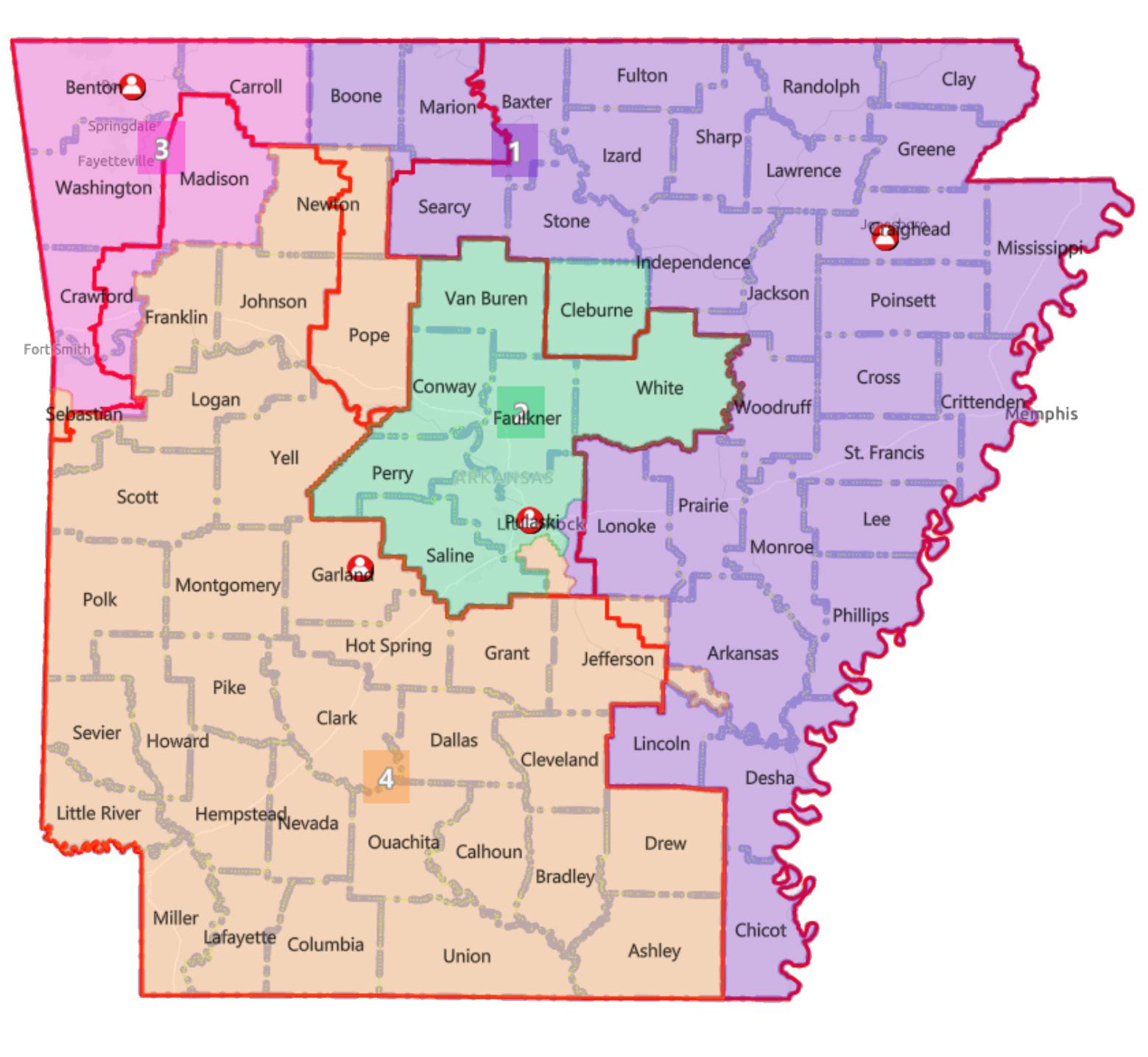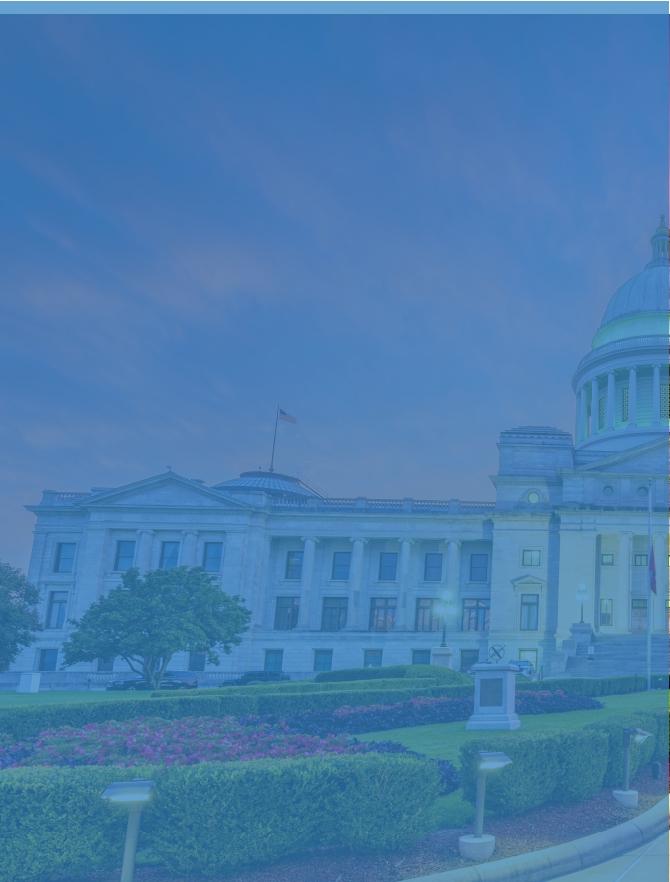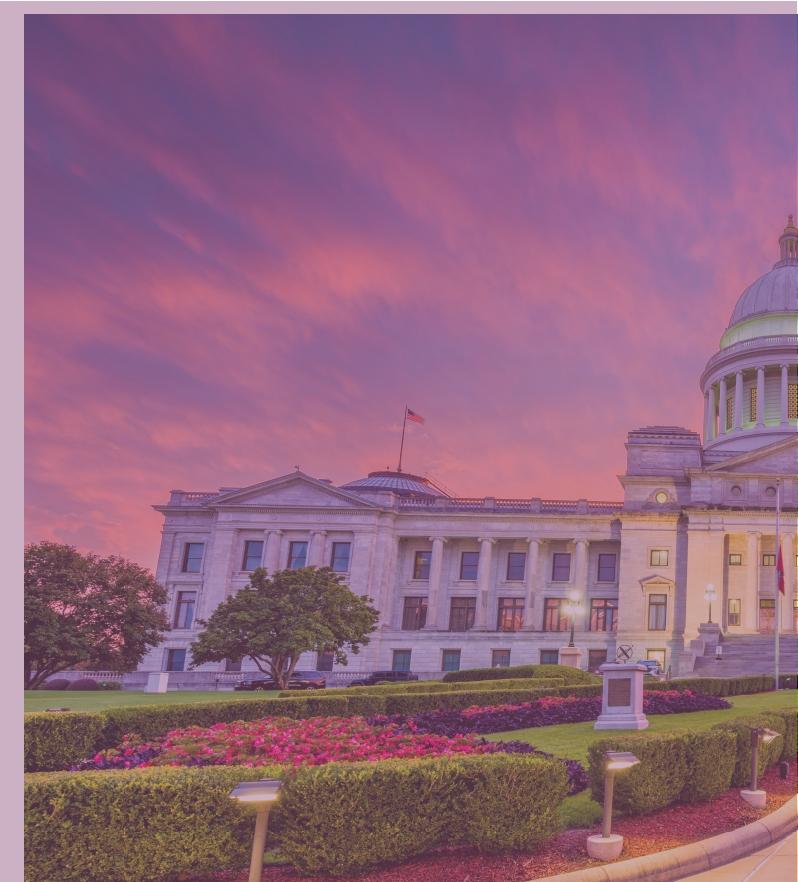
6 minute read
Last Days of the Special Legislative Session
1st Congressional District 2nd Congressional District 3rd Congressional District
4th Congressional District
Last days of the special session
Officials send congressional map, COVID-19 exemptions to Governor.
Story by JORDYN NYKAZA AAC Law Clerk
After meeting from January to April 2021, state legislators returned to the Capitol this fall. Their main task was to draw new boundaries for Arkansas’ four congressional districts, but they also discussed COVID-19 vaccination mandates and exemptions, and more.
The legislature met for 108 days earlier in the year before going into extended recess. Census numbers, used in the redistricting process, were delayed this decennial. Thus, the extended session of the 93rd General Assembly did not convene until Sept. 29. In addition to redistricting, legislators focused their attention on COVID-19 mandates.
Both the House and the Senate maintain an archive of meetings on their websites for constituents to watch. However, here is a recap of the 2021 extended legislative session.
Redistricting
Every 10 years, after Census data has been released by the federal government, the state legislature is tasked with redrawing Arkansas’ congressional districts. Redistricting is not as simple as keeping counties together and separating them based on location for congressional district maps. Redistricting is a formal process with rules stipulated by the U.S. Constitution, as well as the Arkansas constitution. Although it is not always popular to split a single county into multiple congressional districts, it is sometimes necessary to equally split the Arkansas population among all four congressional districts.
Under Article 1, Section 2 of the U.S. Constitution, congressional representatives are to be apportioned to the states based on population. The equal population requirement for congressional districts is strict, as the government wants to ensure the people of each state are equally represented and their vote has as much weight in any congressional district. Under Arkansas’ state constitution, we use a Legislature dominant method to congressional redistricting. This means the legislature has ultimate authority to enact district maps, as opposed to some states that allow a commission, or a commission and the state legislature both to have authority over district maps.
in the House and 32 in the Senate. Of the 61 bills introduced in the House, 19 related to redistricting and five related to COVID-19. Meanwhile, of the 32 bills introduced in the Senate, 14 related to redistricting and 12 related to COVID-19. The remaining 43 bills introduced related mostly to taxes, schooling, and motor vehicle licensing.
While it is interesting to know the volume of bills proposed in such a short amount of time, the people want to know how the legislation passed will change their lives. We will focus on four main bills, all which Gov. Asa Hutchinson allowed to become law without his signature.
House Bill 1982 and Senate Bill 743
House Bill 1982 sponsored by Rep. Nelda Speaks of Mountain Home and Senate Bill 743 sponsored by Sen. Jane English of North Little Rock were twin redistricting bills. The main controversy surrounding these bills is they separate Pulaski County among three districts (the 1st, 2nd and 4th), and they split Sebastian County into two districts (the 3rd and 4th). Nonetheless, the bills passed both chambers.
The House bill, now Act 1114 of 2021, was amended twice by the House then passed on with a 59-30 vote. It then passed the Senate with a 21-12 vote. The Senate bill, now Act 1116 of 2021, passed in the Senate with a 22-10 vote; it passed in the House with a 53-35 vote. Emergency clauses for both bills failed.
With these Acts, the 1st Congressional District will include Arkansas, Baxter, Boone, Chicot, Clay, Craighead, Crittenden, Cross, Desha, Fulton, Greene, Independence, Izard, Jackson, Lawrence, Lee, Lincoln, Lonoke, Marion, Mississippi, Monroe, Phillips, Poinsett, Prairie, Randolph, St. Francis, Searcy, Sharp, Stone, and Woodruff counties. In addition, it includes a portion of Pulaski County.
In addition to a portion of Pulaski County, the 2nd Congressional District is composed of Cleburne, Conway, Faulkner, Perry, Saline, Van Buren, and White counties.
The 3rd Congressional District includes a portion of Sebastian County, as well as Benton, Carroll, Crawford, Madison, and Washington counties.
Finally, the 4th Congressional District includes portions of Pulaski and Sebastian counties. It also consists of Ashley, Bradley, Calhoun, Clark, Cleveland, Columbia, Dallas, Drew, Franklin, Garland, Grant, Hempstead, Hot Spring, Howard, Jefferson, Johnson, Lafayette, Little River, Logan, Miller, Montgomery, Nevada, Newton, Ouachita, Pike, Polk, Pope, Scott, Sevier, Union, and Yell counties.
House Bill 1977 and Senate Bill 739
Both House Bill 1977, sponsored by Rep. Joshua Bryant of
See “REDISTRICTING” on Page 24 >>>
Arkansas’ Premier Pavement Maintenance & Safety Contractor
● Pavement Maintenance Services ● Municipal Road Striping ● Airport Pavement Maintenance ● Guardrail Maintenance ● Traffic Control Services

Call (479)262‐6160
www.custompavement.com

Redistricting
Rogers, and Senate Bill 739, sponsored by Sen. Kim Hammer of Benton, were similar in that they provided “employee exemptions from federal mandates and employer mandates related to Coronovirus 2019 (COVID-19).”
HB1977 was amended once, then passed by the House in a 68-23 vote. The bill passed in the Senate with a vote of 22-12. However, there was debate over the emergency clause, which ultimately failed. The bill became Act 1113.
SB739 passed the Senate with a vote of 21-12. The emergency clause on this bill also failed. The House passed the bill 61-25. It is now Act 1115 of 2021.
These bills give an exemption for employees from mandates related to COVID-19. They require employers that mandate required vaccination or immunization for COVID-19 to provide a specific exemption process. Rather than be vaccinated, the employee is allowed to show either (1) a negative antigen detection test result no more than one time a week that shows the employee does not have COVID-19, or (2) proof of immunity for COVID-19 such as antibodies at most one time every six months from a licensed healthcare provider. The employee can produce test results by a licensed healthcare provider if the test meets guidelines imposed by the U.S. Department of Health and Human Services Food and Drug Administration Center for Devices and Radiological Health. The test will be paid for by state or federal funding made available if it is not covered by the employee’s health benefit plan. If funding is not available, the employee will pay for the test themselves. With this exemption, an employee cannot be terminated for mandates related to COVID-19. If one is terminated, they may be eligible for unemployment benefits in addition to any other remedy available to the employee.
Conclusion
The 93rd General Assembly officially adjourned on Oct. 15, 2021. The Governor has indicated that he plans to call a special session to consider an income tax package. However, during his Oct. 19 media briefing, he said he is “not going to put a time frame on it.”
He said he would like to give employers, taxpayers, and tax preparers time to consider the effects of a tax cut plan. He also said he wants to get “it drafted right” and to ensure a majority of legislators agree to a plan that is “acceptable to me.”
Continued From Page 23 <<<



www. nancial-intel.com www.facebook.com/FISoftwareSolutions










